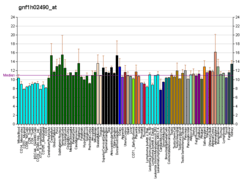NXPH1
| NXPH1 | |||||||||||||||||||||||||
|---|---|---|---|---|---|---|---|---|---|---|---|---|---|---|---|---|---|---|---|---|---|---|---|---|---|
| Identifiers | |||||||||||||||||||||||||
| Aliases | NXPH1, NPH1, Nbla00697, neurexophilin 1 | ||||||||||||||||||||||||
| External IDs | MGI: 107492 HomoloGene: 8284 GeneCards: NXPH1 | ||||||||||||||||||||||||
| |||||||||||||||||||||||||
| |||||||||||||||||||||||||
| |||||||||||||||||||||||||
| Orthologs | |||||||||||||||||||||||||
| Species | Human | Mouse | |||||||||||||||||||||||
| Entrez | |||||||||||||||||||||||||
| Ensembl | |||||||||||||||||||||||||
| UniProt | |||||||||||||||||||||||||
| RefSeq (mRNA) | |||||||||||||||||||||||||
| RefSeq (protein) | |||||||||||||||||||||||||
| Location (UCSC) | Chr 7: 8.43 – 8.75 Mb | Chr 6: 8.95 – 9.25 Mb | |||||||||||||||||||||||
| PubMed search | [3] | [4] | |||||||||||||||||||||||
| Wikidata | |||||||||||||||||||||||||
| |||||||||||||||||||||||||
Neurexophilin-1 is a protein that in humans is encoded by the NXPH1 gene.[5][6]
This gene is a member of the neurexophilin family and encodes a secreted protein with a variable N-terminal domain, a highly conserved, N-glycosylated central domain, a short linker region, and a cysteine-rich C-terminal domain. This protein forms a very tight complex with alpha neurexins, a group of proteins that promote adhesion between dendrites and axons.[6]
References
- 1 2 3 GRCh38: Ensembl release 89: ENSG00000122584 - Ensembl, May 2017
- 1 2 3 GRCm38: Ensembl release 89: ENSMUSG00000046178 - Ensembl, May 2017
- ↑ "Human PubMed Reference:".
- ↑ "Mouse PubMed Reference:".
- ↑ Missler M, Sudhof TC (Jun 1998). "Neurexophilins form a conserved family of neuropeptide-like glycoproteins". J Neurosci. 18 (10): 3630–8. PMID 9570794.
- 1 2 "Entrez Gene: NXPH1 neurexophilin 1".
Further reading
- Ohira M, Morohashi A, Nakamura Y, et al. (2003). "Neuroblastoma oligo-capping cDNA project: toward the understanding of the genesis and biology of neuroblastoma". Cancer Lett. 197 (1–2): 63–68. doi:10.1016/S0304-3835(03)00085-5. PMID 12880961.
- Petrenko AG, Ullrich B, Missler M, et al. (1996). "Structure and evolution of neurexophilin". J. Neurosci. 16 (14): 4360–9. PMID 8699246.
- Missler M, Hammer RE, Südhof TC (1999). "Neurexophilin binding to alpha-neurexins. A single LNS domain functions as an independently folding ligand-binding unit". J. Biol. Chem. 273 (52): 34716–34723. doi:10.1074/jbc.273.52.34716. PMID 9856994.
- Clarris HJ, McKeown S, Key B (2003). "Expression of neurexin ligands, the neuroligins and the neurexophilins, in the developing and adult rodent olfactory bulb". Int. J. Dev. Biol. 46 (4): 649–52. PMID 12141453.
- Strausberg RL, Feingold EA, Grouse LH, et al. (2003). "Generation and initial analysis of more than 15,000 full-length human and mouse cDNA sequences". Proc. Natl. Acad. Sci. U.S.A. 99 (26): 16899–16903. doi:10.1073/pnas.242603899. PMC 139241. PMID 12477932.
- Scherer SW, Cheung J, MacDonald JR, et al. (2003). "Human chromosome 7: DNA sequence and biology". Science. 300 (5620): 767–772. doi:10.1126/science.1083423. PMC 2882961. PMID 12690205.
- Hillier LW, Fulton RS, Fulton LA, et al. (2003). "The DNA sequence of human chromosome 7". Nature. 424 (6945): 157–164. doi:10.1038/nature01782. PMID 12853948.
- Ota T, Suzuki Y, Nishikawa T, et al. (2004). "Complete sequencing and characterization of 21,243 full-length human cDNAs". Nat. Genet. 36 (1): 40–45. doi:10.1038/ng1285. PMID 14702039.
- Gerhard DS, Wagner L, Feingold EA, et al. (2004). "The status, quality, and expansion of the NIH full-length cDNA project: the Mammalian Gene Collection (MGC)". Genome Res. 14 (10B): 2121–2127. doi:10.1101/gr.2596504. PMC 528928. PMID 15489334.
This article is issued from
Wikipedia.
The text is licensed under Creative Commons - Attribution - Sharealike.
Additional terms may apply for the media files.




